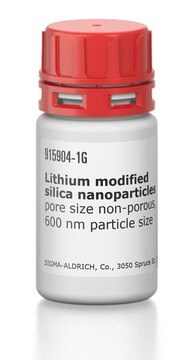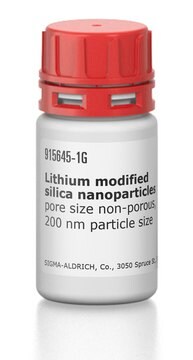930903
Lithium hydroxide monohydrate
battery grade, ≥99.9% trace metals basis
Synonym(s):
Lithine hydrate, Lithium hydroxide hydrate
About This Item
Recommended Products
Quality Level
grade
battery grade
Assay
≥99.9% trace metals basis
form
powder
greener alternative product characteristics
Design for Energy Efficiency
Learn more about the Principles of Green Chemistry.
sustainability
Greener Alternative Product
impurities
≤1000 ppm (trace metals analysis)
mp
423 °C
solubility
H2O: soluble ((lit.))
ethanol: slightly soluble ((lit.))
methanol: soluble ((lit.))
anion traces
chloride (Cl-): ≤50 ppm
sulfate (SO42-): ≤50 ppm
application(s)
battery manufacturing
greener alternative category
SMILES string
[Li+].O.[OH-]
InChI
1S/Li.2H2O/h;2*1H2/q+1;;/p-1
InChI key
GLXDVVHUTZTUQK-UHFFFAOYSA-M
Looking for similar products? Visit Product Comparison Guide
Related Categories
General description
Lithium hydroxide is produced in several ways. Most commonly, lithium carbonate is reacted with calcium hydroxide in a metathesis reaction. This directly yields lithium hydroxide hydrate, which is separated from the insoluble calcium carbonate byproduct and purified. Alternatively, when the source of lithium is spodumene ore, the ore can be converted to lithium hydroxide without first forming the carbonate. In the process, the lithium ore is treated with high-temperatures and sulfuric acid to form lithium sulfate; then the lithium sulfate is reacted with sodium hydroxide to form lithium hydroxide hydrate, which is purified.
Application
Our battery grade lithium hydroxide monohydrate is well-suited for synthesis of nickel-rich metal oxides, like lithium nickel-manganese-aluminum oxide (NMA) and complex quaternary transition metal oxides like Zr-doped or Ti-doped nickel-manganese oxide.
Our lithium hydroxide monohydrate can also be used to synthesize lithium iron phosphates like LiFePO4 or lithium manganese oxides like Li2Mn2O4.
Signal Word
Danger
Hazard Statements
Precautionary Statements
Hazard Classifications
Acute Tox. 4 Oral - Eye Dam. 1 - Skin Corr. 1B
Storage Class Code
8A - Combustible corrosive hazardous materials
WGK
WGK 1
Flash Point(F)
Not applicable
Flash Point(C)
Not applicable
Choose from one of the most recent versions:
Certificates of Analysis (COA)
Sorry, we don't have COAs for this product available online at this time.
If you need assistance, please contact Customer Support.
Already Own This Product?
Find documentation for the products that you have recently purchased in the Document Library.
Our team of scientists has experience in all areas of research including Life Science, Material Science, Chemical Synthesis, Chromatography, Analytical and many others.
Contact Technical Service







